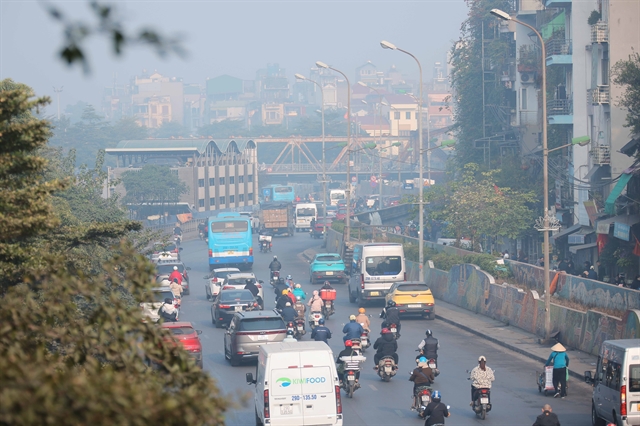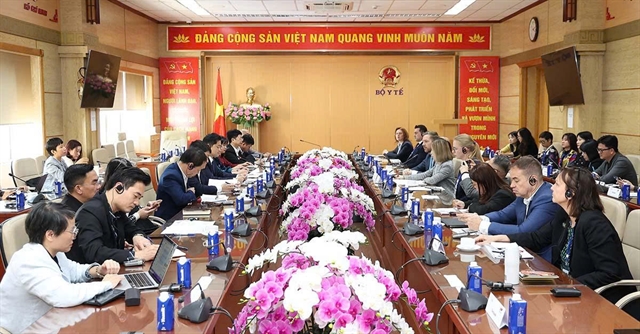.jpg) Society
Society
.jpg)
Nhật Hồng*
HÀ NỘI — Vietnamese cuisine is renowned for its unique and vibrant flavours, with traditional dishes passed down through generations.
But with the growing demands of modern times, local food practices must adapt to preserve their time-honoured essence, while ensuring food safety for the well-being of consumers.
Situated about 45km from the capital city of Hà Nội, Đường Lâm Commune is home to some of the most well-preserved ancient residential architecture of northern Việt Nam.
This is also the hometown of the revered 10th-century warrior king, Ngô Quyền, renowned for his naval victory over northern invaders.
The area is a popular destination for both local and foreign tourists, who come here to enjoy the charm of hundred-year-old houses and the vibrant culinary traditions with unique delicacies such as soybean paste, rotisserie pork and peanut candies.
However, the rising influx of visitors and the increasing demand for these specialities mean locals have to make greater efforts to uphold food safety standards, while continuing to preserve their generations-old culinary crafts.
“Food safety is essential because it directly affects the health of consumers,” said Kiều Việt Sơn, whose family owns a renowned thịt quay đòn (rotisserie pork) production facility in Đường Lâm.
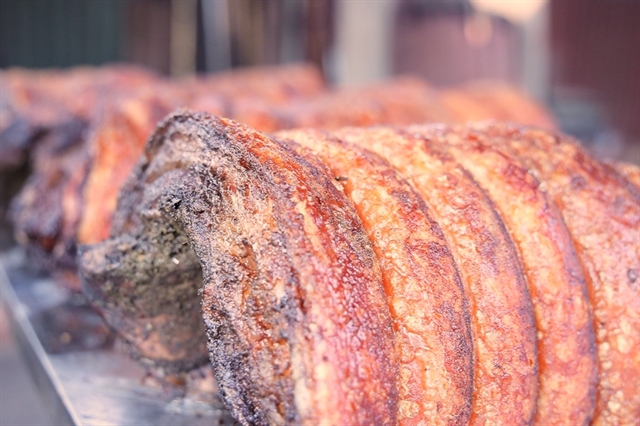 |
| The crisp-skinned, juicy thịt quay đòn (rotisserie pork) is a signature dish of Đường Lâm ancient village complex in the outskirts of Hà Nội. — VNS Photo Trinh Nguyễn |
The herb and spice-infused roast pork, cooked on bamboo poles over a coal fire, is a signature dish of Đường Lâm.
Its recipe is said to date back over 1,000 years, when King Ngô Quyền defeated invaders at the Battle of Bạch Đằng in 938 and ordered a feast of roast pork to celebrate with his army.
Sơn’s family business, named Thịt quay đòn Lương Hương after his parents, produces about 200-300kg of traditionally roasted pork every day for restaurants and catering services in the area.
In the past six months, they have been an active participant in the Canada-funded Safe Food for Growth project (SAFEGRO) to incorporate modern food safety standards.
With the support of SAFEGRO, they have replaced wooden preparation tables with stainless steel ones, preventing water pollutants, contamination with wood chips and stopping bacteria.
These impurities can carry chemical, physical and biological hazards – polluted water, cutting board debris and pathogenic microorganisms – which contaminate production.
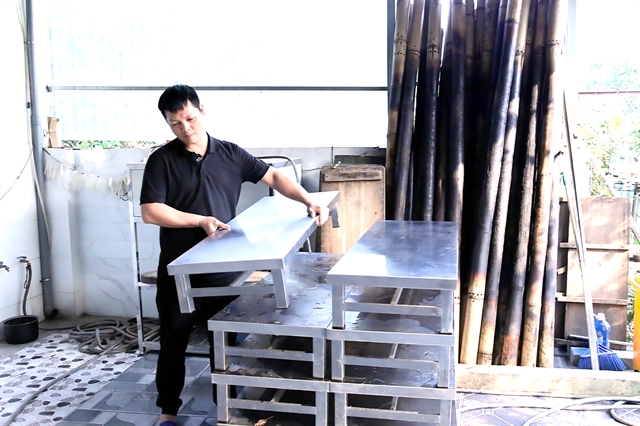 |
| Sơn’s family business now uses stainless steel tables to prevent contaminants to their rotisserie pork during the cooking process. — VNS Photo Trinh Nguyễn |
The facility also paid out of its own pocket VNĐ15 million (US$590) to line its cement floor with ceramic tiles to minimise dust and dirt and allow for easier cleaning.
In addition to their facility upgrade, staff at Thịt quay đòn Lương Hương were trained on proper meat processing and the importance of using safety gloves when handling the pork.
Only 500 metres away from Thịt quay đòn Lương Hương is its long-time client Bếp Làng Đường Lâm (Đường Lâm Village Kitchen), a popular restaurant that serves traditional dishes from northern Việt Nam.
The restaurant is another example of a successful collaboration between SAFEGRO and local businesses to bring food safety into traditional cuisine.
With the same proactive mindset of Thịt quay đòn Lương Hương but on a larger scale, Bếp Làng Đường Lâm spent VNĐ78 million ($3,050) to upgrade their kitchen, in addition to the hygienic equipment and supplies from SAFEGRO.
Following the project team’s recommendations, all the cabinets and table surfaces in the kitchen were changed to stainless steel for hygienic food handling.
In addition to a dish dryer received from SAFEGRO, Bếp Làng Đường Lâm also paid for a kitchen lift and an industrial-grade ultrasonic sink to properly handle their large daily volume of tableware.
The restaurant’s owner, Lâm Thị Na, told Việt Nam News: “Since partnering with SAFEGRO, our kitchen has undergone significant changes in terms of facility and processing conditions.
“We learned a lot and enhanced our skills in food safety with SAFEGRO. They helped improve our facility conditions and raise awareness among our staff on hygienic food handling practices, ensuring that our customers are served safe, healthy meals.”
Upgraded spaces, elevated mindset
As part of the project activities in Đường Lâm, SAFEGRO has held training sessions on food safety principles and practices for more than 50 people in the commune.
They are people whose actions directly impact food safety within the community, including local officials, business owners and food production staff, including employees of Thịt quay đòn Lương Hương and Bếp Làng Đường Lâm.
The restaurant’s manager Cao Minh Luyến said: “Our staff had learnt about food safety practices and procedures before SAFEGRO activities were launched in the commune. But with the training support from the project and its experts, we improved significantly in terms of awareness and skills.”
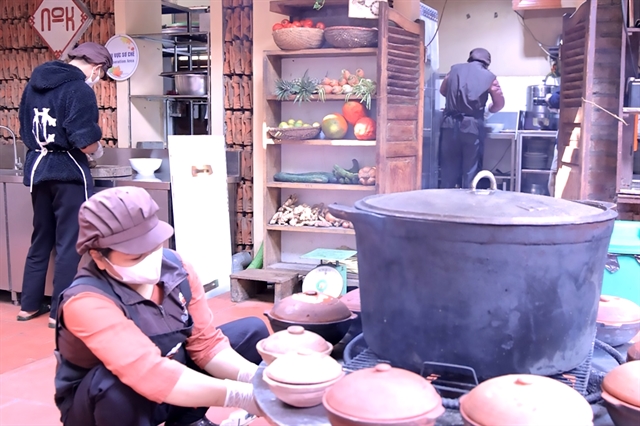 |
| The kitchen of Bếp Làng Đường Lâm, a popular restaurant in Đường Lâm ancient village complex, is now divided into different areas to handle raw and cooked food. — VNS Photo Trinh Nguyễn |
In the past, food preparation and plating were done in the same kitchen space, which posed cross-contamination risks between raw and cooked food.
“Their training helped us be aware of those risks, and now our kitchen has a wet station and a dry station, separating raw ingredients from cooked food,” Luyến said, adding that utensils, cutting boards and food storage were also divided accordingly.
She added: “When I attended the training sessions, I realised that food safety and hygiene have tremendous importance as they directly affect the consumers. We must join hands to raise awareness and improve food safety standards.”
Safety and sustainability
Food safety has long been a priority of Đường Lâm, which welcomes more than 100,000 domestic and foreign visitors a year on average. In the post-pandemic recovery, this complex of ancient villages saw a record number of 650,000 tourists in 2023.
Local authorities have established a steering committee for food safety, which conducts periodic and unscheduled inspection visits to local food processing and production facilities.
The commune’s economic department also provided training to business owners and workers in the food and culinary sector.
Chairwoman of the commune’s People’s Committee Phạm Thị Lệ Thủy said: “We very welcome SAFEGRO in Đường Lâm as they help us improve our knowledge and our promotional activities. The project also supports us with new equipment and guidelines [on food safety.]
“Here, food safety is intertwined with culture, heritage and history, which can have a great impact all together.”
Head of agricultural product quality at the National Agro-Forestry-Fisheries Quality Assurance Department Nguyễn Văn Thuận also shared a similar perspective on local cuisine, culture and tourism.
“Culture, cuisine and tourism are linked to food product development, especially traditional delicacies, OCOP products and local specialities,” he said.
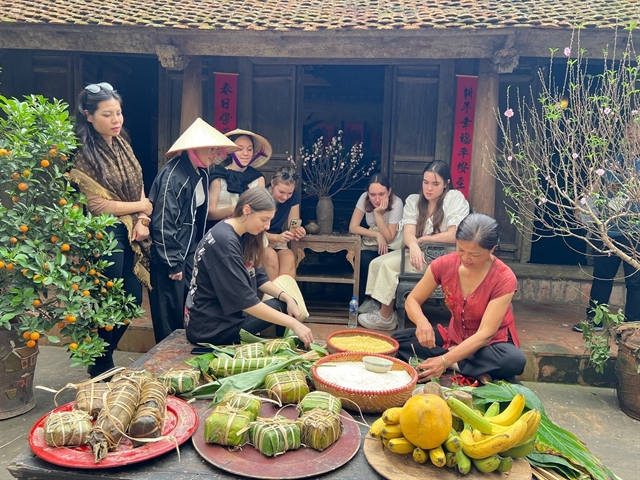 |
| Tourists try their hands on making bánh chưng, a signature dish during the Tết (Lunar New Year) holiday at Đường Lâm Commune, Hà Nội. — VNA/VNS Photo Đinh Thuận |
According to Thuận, the current model of Đường Lâm is crucial to boosting consumption and tourist attraction, but there is room for improvement for better value and quality, craft village production, local employment and tourism development.
“These should be the criteria and the goals to deploy supporting activities in terms of food safety and quality, as well as brand building and market development,” said Thuận.
“The ultimate results that we expect are benefits for local businesses, the locality and its traditional culinary tourism, and furthermore, the economic development of this Sơn Tây area – which possesses rich history and culture,” he explained.
Support from foreign partners, such as Global Affairs Canada which funds SAFEGRO, helps locals keep the essence of their culture, tourism and cuisine yet elevate them to more modern, better standards for food safety.
Thuận said: “The [SAFEGRO] project has been deployed in the country for four years, and during this time, we have witnessed a lot of changes in terms of awareness, mindset and practices. That is where sustainability is, rather than small-scale, specific results.
“The project might support us for a few years, but what is important is operational practices from the Vietnamese side. We aim to initiate strategic direction and thinking so that when the project concludes, the locals can continue to take charge.
“We don’t expect that these activities end when the project finishes, we aim for a bigger impact just as the full name of the project – Safe Food for Growth.” — VNS
*With additional reporting from Trinh Nguyễn
.jpg)

